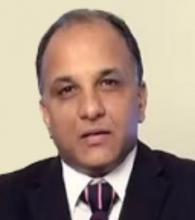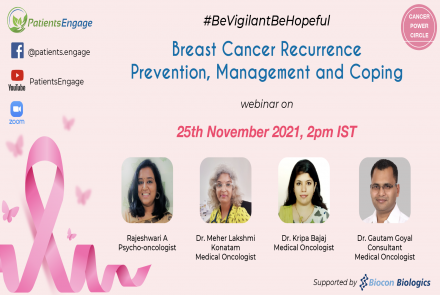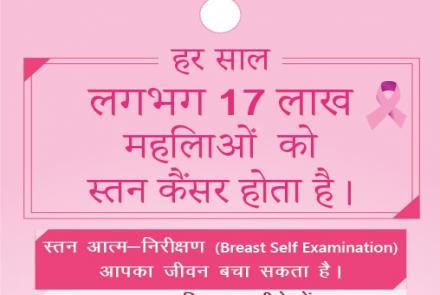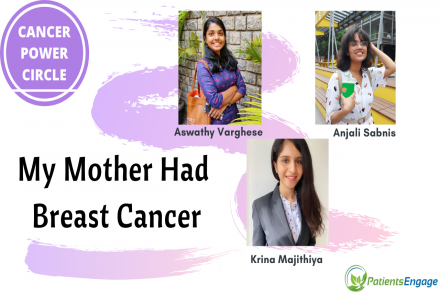
An interview on a wide range of issues - from survival rates of breast cancer to quality of life, from the use of chemotherapy to breast reconstruction - with Dr. Vinay Deshmane, Consultant in Surgical Oncology & Breast Diseases and Medical Director and Jnt. Hon secretary of the Indian Cancer Society
1. Has the survival rate of Breast Cancer changed in India in recent years? Why is that?
There is paucity of data on survival rates of most cancers including Breast Cancer in India.
The Mumbai Cancer Registry, India’s oldest Population Based Registry reports 5 year survival rate of people living in Mumbai to be 55 %. ie. 55% of all the Breast Cancer affected patients in Mumbai will survive for 5 years. This is similar to data from other parts of the country.
These give a realistic snap shot of what is happening in the local community as all patients living in a specifically designated area (Greater Mumbai) are taken into account by a population based registry.
This is unlike hospital-based data that refers to a specific subset of national population draining to that particular hospital. Individual hospital outcome rates will vary depending on the institute, reflecting the socio economic strata being treated, the level of expertise and the available treatment modalities.
This survival rate is far lower than the 85% 5 year survival noted in most developed nations.
Why?
It is well known that survival rates improve with earlier detection and adequate treatment. Unfortunately, data from the Mumbai cancer Registry suggests 50% of Breast cancer patients in Mumbai still present in an advanced stage. This is also reflected in other urban cities of India. This results in a poorer overall outcome compared to the west.
The relatively low survival rate is due to 3 A’s.
Awareness, Availability of treatment facilities and Access to treatment facilities.
- Awareness leads to early detection of cancer when long term cure is possible and current treatments are more effective. Early treatment also results in a better quality of life.
- Availability of adequate treatment facilities in terms of trained personnel and technical facilities viz surgical, medical and radiation oncologists as well as radiation therapy machines, is imperative to achieve the best results possible. There is a lack of dedicated cancer specialists in the country. Breast Cancer is currently treated by all doctors, and although the specialty is slowly being recognized it will take a long time for it to develop to the level seen in the west. So while we have islands of expertise, providing treatment comparable to that available at the best centers in the world, these are inadequate to treat the large number of Breast cancer patients.It is not just clinicians that are needed. We need better and more radiologists, pathologists and radiation therapy centers too. This is now being addressed.
- Access: Even if adequate treatment facilities are available, these should be accessible to the Community. Access may be limited or not possible due to socio – economic factors. This results in poor outcome.
2. What steps are taken to improve the patient’s quality of life during their cancer journey?
- Information
- Inclusion in decision making (informed decision making)
- Providing adequate time to make decisions
- Including quality of life issues while planning treatment
- Evaluation of risk benefit ratio of a particular treatment
- Multi-disciplinary approach
- Oncoplastic techniques in surgery (High quality surgical techniques)
- Preoperative drug treatment in decreasing tumour size to enable breast conserving surgery
- Advances in treatment….minimising side effects
- Individualising of treatment
- Adequate measures to improve quality of life post treatment includes rehabilitation, addressing fears and misinformation, prosthesis, reconstructive surgery etc.
3. Recently, the American Heart Assoc. issued a warning of increased risk of serious cardiac issues seen in Breast Cancer patients due to chemotherapy & radiation. What can be done to minimize such risks? Is the risk to the heart considered before deciding on course of treatment?
Certain drugs associated with cardiac toxicity include anthracyclines, trsatuzumab etc. Dosage of such drugs should be calculated carefully and decreased as necessary. Cardiac function should be monitored for all cancer patients to reduce risks of any cardiac events.
If the breast tumor is located on the left, radiation therapy on the left can affect heart as well as lung function; this is the case more so with old machines. Certain tumors located around the lungs and heart tend to move as the patient breathes making it difficult to map the tumor for precise radiotherapy delivery. Latest technology has newer respiratory-gated machines integrated with Radiotherapy that deliver radiation to the specific tumor site as per movement. This prevents broad radiation to the entire surrounding area and helps spare the healthy tissues. Lung fibrosis has also been noted to be mild with the new machines.
4. Post treatment, what lifestyle changes are advised to the patient?
None, unless the patient has any pre-existing disease/condition. A patient following treatment of breast cancer is a normal individual capable of living normally. I dislike the word survivor for these patients! These are normal people and can do everything a normal person can. If a person has had removal of lymph nodes under the arm pit, it is reasonable for them to avoid blood collection, blood pressure measurements and injections in the operated arm to avoid development of arm swelling due to lymphedema. However, even these can be carried out in an emergency.
5. Do you prescribe any dietary changes or precautions for your patients?
No, these are normal people and can have a normal diet and enjoy their life. Most patients are on some diet or the other. While being on a healthy diet will have a beneficial effect on the body in general, there is no specific diet for breast cancer patients.
6. Is Scar-less surgery a safe alternative for Breast reconstruction? Has it been performed in Mumbai yet?
Scar-less surgery is a misnomer. It refers to small incisions/ hidden incisions. These have been around for some time and form an integral part of Breast Surgery.
In Plastic Surgery:
Hidden scars or small scars are used in plastic surgery to augment the Breast Size or in reducing the Breast Size. While augmenting, smaller incisions are used in the armpit, around the nipple or below the breast. More recently, the armpit ones are used as these scars are not very visible to the eye and remain well hidden. The scar around the nipple areola is also well disguised and not seen due to the crinkled natural appearance of the areola. There are some limitations to the size of the prosthesis that can be used via such small incisions.
In augmentation, the term Scar-less Surgery is also used to describe procedures which used fat filling (lipofilling) without the use of prosthesis. Here, tiny cuts are used to introduce fat into the breast to make it appear larger.
In Breast reduction:
The term Scar-less surgery is used to describe techniques using liposuction (sucking out fat) from the breast to make them smaller as against the use of regular breast reduction incisions.
In Breast Reconstruction:
Following a mastectomy, the breast is often reconstructed using skin and muscle or only muscle from the back to provide adequate cover for a breast implant. This is known as the Lattisimus Dorsi flap and is commonly used in immediate breast reconstruction along with a breast implant (prosthesis).
The aim is to cover the implant completely. It is usually done using a second incision over the back and a small ellipse of skin along with the underlying Lattisimus Dorsi muscle( with its blood supply) dissected and moved to the breast from the back (swung like a pendulum). Sometimes only the muscle is used, and when this is done it may be possible to avoid the skin incision on the back. Avoiding this skin incision on the back while using the Latissimus dorsi flap has been referred to as “scar less”. This does not mean that there is no scar on the breast.
We have used the latissimus dorsi flap using only the muscle without the skin on the back, which has avoided this incision on the back, many years ago. We have used it for partial breast reconstruction without an implant. This procedure was popularized nearly two decades ago. The Latsimmus Dorsi flap has also been harvested/ dissected using endoscopy, which also avoids the scar on the back.
Today the role of autologous reconstruction in breast surgery is diminishing. While the Lattisimus Dorsi flaps and the TRAM flaps (which used muscle and skin from the back or the abdomen) were popular in the 90’s and early 2000’s, their popularity has been diminishing. This is due to the morbidity associated with these procedures as well as the resurgence of Expander – Implant based reconstruction.
Expander – Implant based reconstruction are less morbid procedures and, if they fail, still allow one to undertake more extensive operations like the autologous flaps (either with the pedicle or as a free flap). They are relatively quick and do not involve incisions on the back (and are thus another version of “scar less” reconstruction).
Further the whole role of breast reconstruction itself has diminished. There are 4 groups of patients in clinical practice:
- Patients with small tumours who can undergo breast conservation surgery but still would prefer a mastectomy! (Mastectomy group)
- Early / small breast tumours which can undergo breast conservation surgery with excellent cosmetics (Breast Conservation group)
- Larger tumours which can be down-sized in the majority of patients with the use of systemic drugs. This downsizing of the primary tumour can then allow breast conservation surgery safely with an excellent cosmetic result. (Neo adjuvant treatment group)
- Patients with extensive disease who despite drugs do not respond. These need a mastectomy and are candidates for breast reconstruction. (Mastectomy +/- reconstruction group).
Only some of these will want a breast reconstruction. Of those who want breast reconstruction, the majority if counseled adequately, will be happy with the expander – implant based reconstruction while a small group will want a more major surgery in the form of autologous reconstruction (Lattisimus/ TRAM/ Free flap). It is important to discuss the pros and cons of all these procedures with the patient in detail. An adequately counseled patient is in a position to make a well informed decision. The clinician should explore or discuss all avenues of treatment/ reconstruction available to a patient.
Here the role of Oncoplastic Breast Surgery needs to be appreciated.
Oncoplastic Breast Surgery comprises new surgical techniques that combine the principles of cancer surgery with those of plastic surgery, with the aim of optimising cancer cure while maintaining the shape and symmetry of the Breast. These surgical procedures improve the quality of life of the patient with Breast Cancer. Over the last two decades, these oncoplastic techniques have radically changed and expanded the boundaries of Breast Conservation.
These Modern Breast Conservative Surgical techniques have expanded the pool of patients who could undergo Breast Conservation. Today, even patients with large lesions may undergo preservation with the use of pre operative Drug treatment to shrink the size of the tumour in the breast and then undergo “Oncoplastic Surgery” which allows large areas of the Breast to be removed without compromising cosmetics and without the need for extensive reconstructive procedures. With the help of the Indian Cancer Society, I recently organized the first “Mumbai Oncoplastic Breast Surgery Course” at the Breach Candy Hospital, Mumbai, to popularize these techniques.
7. Breast surgeries can be cosmetically and emotionally scarring. How do you manage your patients during such difficult times? What advice do you give caregivers and spouses?
Most patients are emotionally distressed on receiving a diagnosis of Breast Cancer. They are scared and largely misinformed, having received incorrect/ inaccurate advice from well -wishers. The most important aspect of management is to put them at ease, and explain to them in simple terms that they need to understand the disease process. They need to comprehend that it is not an emergency, and that they have time to think things over so as to make a proper decision.
It is important to get to know the patient and the family. In India it is often family pressures that push the patient into making a certain decision. It is thus important to get to know, and to win, the confidence of the family members too.
All treatment options need to be explained. The duration and extent of treatment as well as the basis or rationale for each treatment needs to be explained. Sometimes this needs to be done over and over again. There are choices to be made in Breast Cancer Management. Once this is achieved the patient is in control to make her decisions.
I encourage the patient and her family to think about all possible questions and to make a list. I try to sort these out and explain them in detail prior to admission. Once all queries are satisfied, most patients are more in control of their decision making and the family is also happy in encouraging the patient to make her own decisions.
Interestingly, my experience with Indian patients suggests that, they are happy accepting a mastectomy even when their breast can easily be saved by breast conserving surgery. There are many factors which contribute to this namely:
- Not wanting radiation therapy (cost of radiation therapy treatment plus extra time of 1 month taken to complete treatment)
- Wanting to get back to normal life ASAP
- Other responsibilities ….children /exams etc
- Pressure from family members and well wishers who feel that Mastectomy is a safer operation
8. What type of prosthesis is currently available for Br Ca patients?
External breast prosthesis:
These are worn in special bras that have a compartment for the prosthesis to be slipped into. Today, a large range of different bras for mastectomy patients are available.
Swim suits which incorporate a prosthesis, are also available.
Breast implants:
Breast implants are of different types. These are Silicone gel based; they come in different sizes and the correct size needs to be determined for a given patient. Variables include the width, the height and the projection.
They are of 2 main types:
- Round
- Anatomical (which tries to replicate the shape of the breast eg. tear drop etc.)
Unfortunately, as Breast Reconstruction is not very popular as yet in our country, the anatomical Breast Implants are not easily available and may need to be ordered in advance. Round implants are more easily available. Overall, there is a paucity of suppliers of Breast Prosthesis in the country.
9. Do you commonly send your patients for counseling? Do you think such in-house facilities (related to patient care) need to be provided in all hospitals/clinics?
An important aspect of all cancer treatment including Breast Cancer is appropriate counseling. Unfortunately, there is a dearth of good counselors. Abroad, this aspect is undertaken by “Nurse Specialists”. A good Nurse Specialist is extremely useful in coordinating the overall management. Except at major centers, and some pockets of excellence, counselors are often not available. In the absence of well-trained counselors or nurse specialists, appropriate counseling needs to be undertaken by the treating physician. Our patients are not tuned to “non doctors” providing advice. Patients and family members often are not open to counseling as is practiced in western society. This may change over the years. As of now it is mainly doctors who need to do the counseling.
10. Many Oncologists are shifting towards ‘de-escalation’, which is minimum or no chemotherapy at all for low risk Br Ca patients? What are your views on this and its effects in the Indian scenario?
This is true!
Chemotherapy of Breast Cancer was sparingly used in in the 60s and 70s. As the medical community realized the use of this effective treatment modality, its use increased in the late 80s and 90s. It went on to become aggressive in the later part of the 90s and early 2000s. Over the last decade there has been a slow realization that Chemotherapy has been over utilized, and that it has failed to live up to expectations. At the same time, advances in our understanding of Breast Cancer have led to the discovery of Breast Cancer subtypes which are associated with different behavior and response to treatment.
The role of genomic testing has been increasing and its effect in predicting both outcome as well as the relative benefit of chemotherapy has led to “Personalised Medicine”. This has helped in avoiding chemotherapy where its effect on outcome is limited or where the risk to benefit ration does not favour the use of chemotherapy. Thus, there is a major move to de-escalate the use of chemotherapy in clinical practice which is a welcome as chemotherapy, although a useful treatment modality is associated with significant side effects.
In my practice, I have moderated the use of chemotherapy. When feasible and appropriate, I have used subtyping of Breast Cancers and genomic tests to determine the utility of chemotherapy. This has enabled me avoid chemotherapy in patients where its effect is likely to be low or unclear.
As Personalised Medicine is increasingly applied across India there will be a drop in the overall use of chemotherapy, resulting in significant decrease in costs, time and undesirable morbidity associated with chemotherapy. Unfortunately, in India, due to the lack of uniformity in availability and access to treatment this de–escalation of treatment may take time to be widely practiced in the country.
Dr. Vinay Deshmane, MS, DNB, FRCS (Glasg), MD (London), FICS. Consultant in Surgical Oncology & Breast Diseases associated with the Breach Candy Hospital, Hinduja Hospital, and the Asian Cancer Institute, Mumbai.
He is the Medical Director and Jnt. Hon secretary of the Indian Cancer Society. He is the Editor of the Indian Journal of Cancer, and the Principal Investigator for the Mumbai Cancer Registry, India’s oldest Population Based Cancer Registry programme. He has pioneered the use of breast endoscopy in the country. His areas of special interest include: Breast Cancer, Oncoplastic Breast Surgery, Molecular Biology of Cancer, Tumour Profiling and genomics.

















